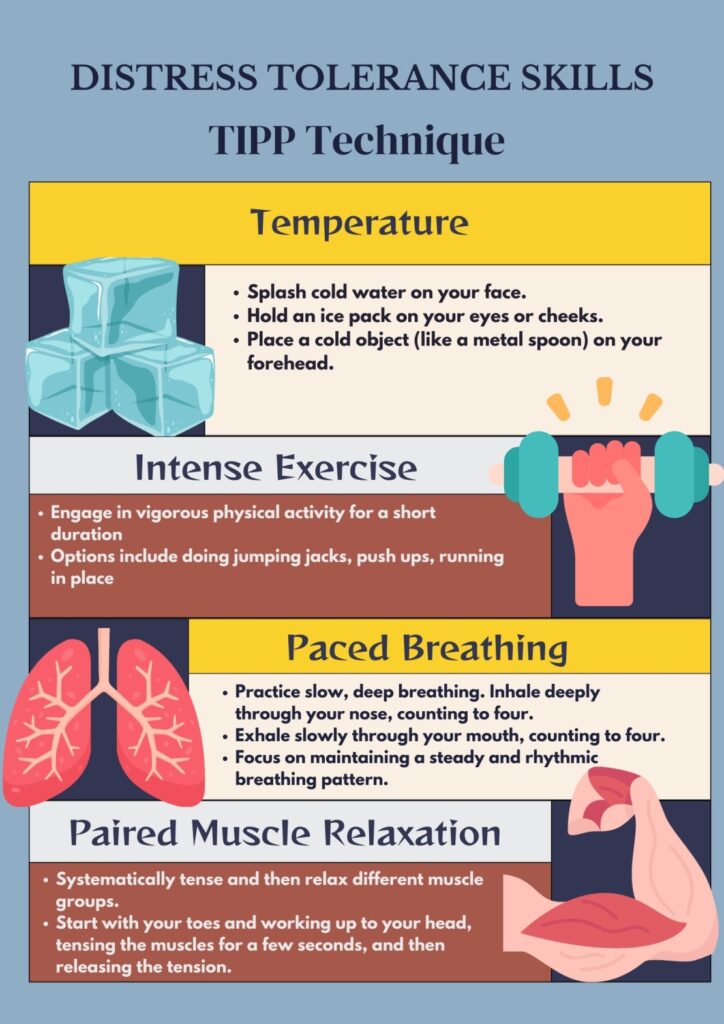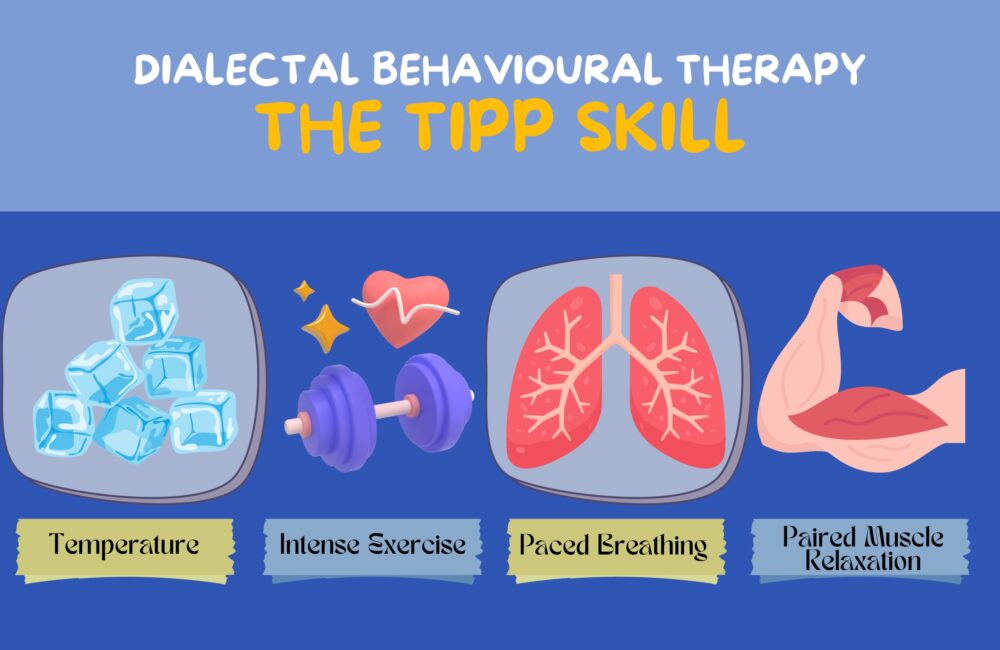Stress challenges our mental stability in every sphere of life. There is no predicting when we are about to be affected by it; there could be problems at work, financial instability at home, relationship issues, or even the death of a loved one. At some point or another, stress will overwhelm us with its intensity of emotions that are hard to cope with. The inability to manage stress could lead to worse mental issues like anxiety and depression. You can’t eliminate stress, but you can control how you respond to it. A trending way to deal with stress advocated by several therapists today is dialectical behavior therapy (DBT).
Dialectical Behavior Therapy (DBT) is a comprehensive and evidence-based therapy designed to help individuals manage overwhelming emotions and build a life worth living. It involves practical coping skills such as emotional regulation, mindfulness, interpersonal effectiveness, and distress tolerance. However, among these, it is the TIPP skill which stands out as a powerful technique to combat stress.
What is Dialectical Behavior Therapy (DBT)
Dialectical Behavior Therapy, developed by Dr Marsha M. Linehan in the late 1980s, was initially designed to treat individuals with chronic suicidal thoughts and self-harming behavior. Over time, its applications have broadened to address a range of emotional and mental issues, including mood disorders, substance abuse, eating disorders, anxiety, post-traumatic stress disorder (PTSD) and depression. DBT is based on cognitive-behavior therapy (CBT), a type of therapy that helps people understand the connection between their thoughts, emotions, and behavior. Like CBT, dialectal behavior therapy also adopts the concepts of acceptance and mindfulness, creating a holistic and integrative approach to mental health.
The term “dialectal” means an integration of opposites, which in DBT involves finding a balance between acceptance and change, validation, and problem-solving. Through DBT skills, people afflicted with mental issues can learn how to cope with their thoughts and emotions to lead a better quality of life. The main goal of DBT is to validate conflicting emotions while working towards constructive change.
The Core Modules of DBT
DBT, as mentioned earlier, consists of four core models, each targeting specific areas of emotional regulation. These are specifically designed to help people manage their thoughts, emotions, and behaviours, including episodes of depression, anger, anxiety, and stress.
- Mindfulness: Based on Eastern spiritual traditions, mindfulness in DBT focuses on cultivating awareness of the present moment without judgment. Mindfulness helps people remain calm and slow down to observe and describe their thoughts, feelings, and sensations, laying the foundation for effective emotion regulation.
- Emotion Regulation: This module aims to develop healthier ways of understanding, experiencing, and managing emotions. Individuals learn to identify and label emotions, understand the function of emotions, and develop strategies to modulate intense emotional experiences.
- Interpersonal Effectiveness: Focusing on improving communication and relationship skills, interpersonal effectiveness helps individuals navigate social interactions, set boundaries, and assert their needs without compromising self-respect.
- Distress Tolerance: Providing skills for crisis management, teaching individuals how to endure and survive overwhelming emotions without making impulsive and harmful decisions. In distress tolerance, people also learn to weigh the pros and cons before making impulsive decisions and acting upon urges. It is distress tolerance that gains the most focus in DBT mainly because of TIPP skills, which are part of its coping mechanisms.
The TIPP Skill of DBT
TIPP stands for Temperature, Intense Exercise, Paced Breathing, and Paired Muscle Relaxation. DBT TIPP skills are among the variety of skills taught in DBT, instrumental in moments of acute distress or intense emotions. TIPP skills are easy to employ and have been proven to provide fast relief from states of emotional arousal. It also helps in managing challenges effectively.
Temperature (T)
The temperature in TIPP involves altering your body temperature through simple actions like splashing cold water on your face or holding an ice pack on your eyes or cheeks. You could even dunk your head in a sink full of cold water, which works equally well. This concept is rooted in the connection between the body and mind, where intense emotions can be cooled down. Alternately, to change a state of numbness or disassociation, use warm water, a hot shower, or a warm pack. The physiological impact of temperature has been proven to state how cold temperatures can activate the mammalian diving reflex, reducing heart rate, and promoting a calming effect, while warmth can induce a sense of comfort and security. However, it is essential to note that one should not resort to the temperature skill if suffering from any medical condition. Please consult a doctor first.
Intense Exercise (I)
Physical activity is a powerful tool for regulating emotions. Engaging in approximately 20 minutes of intense exercise, such as jogging, brisk walking, aerobics, or jumping jacks, can release endorphins, the body’s natural mood lifters. Exercise increases your heart rate, pumps you up, and releases pent-up anger, frustration, and tension to induce a sense of well-being.
Paced Breathing (P)
Controlled breathing is associated with mindfulness and involves slowing down your breath to regulate arousal levels and promote relaxation. The suggested breathing pattern for this is to breathe out slower and longer than when breathing in. For example, breathe in for 4 seconds and breathe out for 5 seconds, increasing to 6 and 7 seconds once comfortable with the process. This deliberate and controlled breathing activates the body’s parasympathetic nervous system, reducing the physiological markers of stress and making you feel secure and safe.
Paired Muscle Relaxation (P)
Paired muscle relaxation is a technique where muscle groups are tensed and then relaxed systematically. Inhale for 5-6 seconds while tensing your muscles, experience the feeling and then relax them while exhaling, being mindful of the process. The focus here is on quickly inducing a relaxation response by combining muscle tension and release. The principle behind this technique is that the physical act of releasing tension in the muscles signals to the brain that it’s safe to relax. This, in turn, can contribute to a reduction in overall stress.
Examples of Tensing muscles
- Clenching your fist
- Clenched fists with tensed forearms, biceps, and triceps
- Raise shoulders as high as possible
- Shut eyes tight
- Face grimace, raising lips and cheeks
- Pushing chin into the chest
- Tensing abdominal muscles
- Pointing toes downward to tense calves
- Curling toes with heels out
Incorporating the TIPP skill into one’s daily life requires practice and commitment. As you practice and become more familiar with the process of TIPP, you can use it to intercept intense emotions before they spiral out of control. The power of TIPP lies not only in its simplicity but also in its ability to provide an easy and accessible means of emotional regulation. TIPP provides an instant intervention in situations of anxiety, stress, frustration, anger, or experience that is emotionally distressing. It is an invaluable resource to help navigate the stressors that challenge your mental health for a more balanced and stress-controlled life.
Distress Tolerance Skills: TIPP Technique Infographic
















